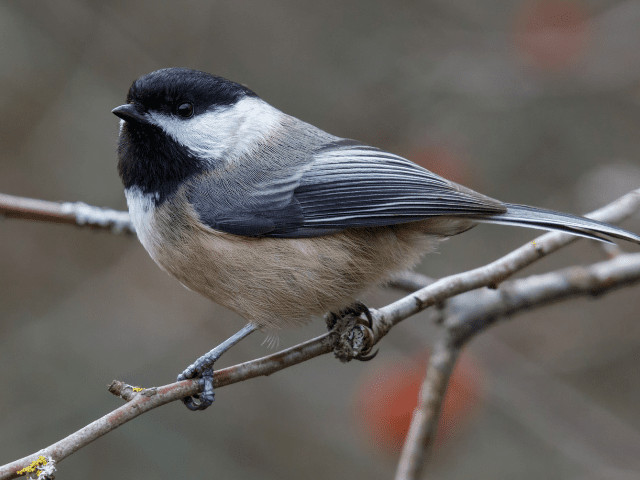Utah has so many species only found in the western states. It's also along the migratory route of some birds that winter north or south.
Therefore…
Let's look at a variety, both species that frequent bird feeders and the ones you have to see in mountain forests or at the coast.
We'll also talk about a few places to see the birds of Utah.
Birds To See In Utah
1. Black-Chinned Hummingbird
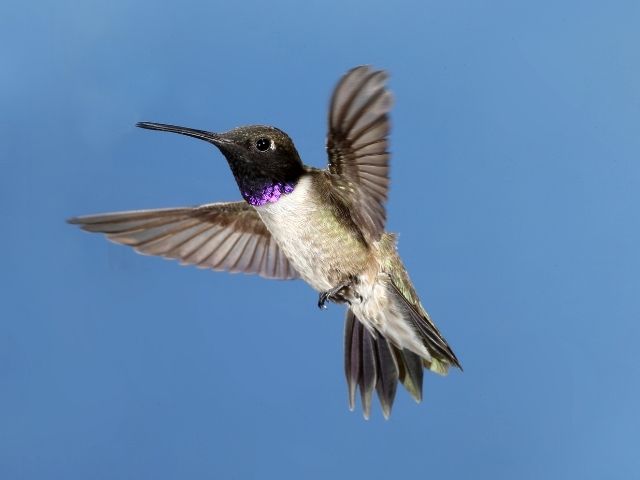
Utah has a breeding range of the black-chinned hummingbird that extends to neighboring states like Arizona, Colorado, New Mexico, and Nevada.
It lives in deserts, along rivers and mountain forests, spending most time perched on a bare branch. It's a small species that grows to 3.5 inches, over two inches smaller than a house finch. A marsh wren is also larger than this hummingbird as its size ranges from 3.9 to 5.5 inches.
Like other hummingbirds, you'll know it by its thin, sharp bill, an iridescent purple throat for a male, and a pale one on female birds. Both sexes have greenish upperparts and grayish-white underparts.
These birds don't build their nests very high; thus, you may find them between six and twelve feet from the ground, far from a canopy.
2. California Gull
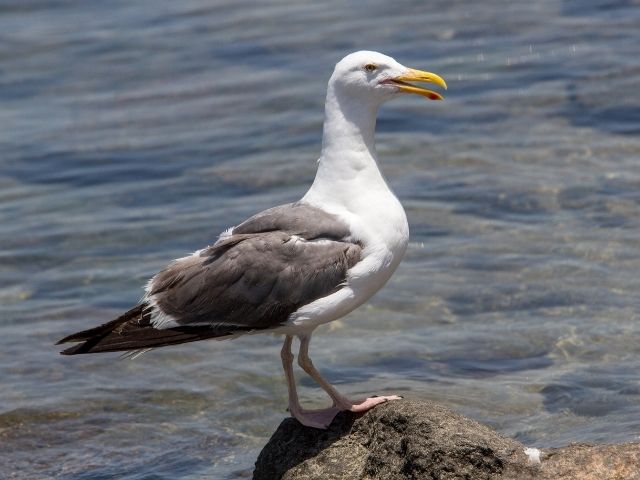
It became the Utah state bird in the mid-1800s when it ate destructive crickets and saved crops.
The California gull is a stunning bird with different colors depending on the season, and you can see it in the Great Lake Salt region.
When you spot a breeding adult, you'll notice yellow legs, a red patch on the tip of the lower bill, a white head, and white underparts. A nonbreeding adult has a streaked head and neck.
California gulls have long, pointed wings, and they grow between 18.5 and 21.3 inches long.
They forage in farms, beaches, estuaries, meadows, and garbage dumps. Further, California gulls nest in colonies, and they sometimes go back to the same nest the following year.
These gulls eat almost anything from earthworms to bird eggs, insects, and fish.
3. Black-Capped Chickadee
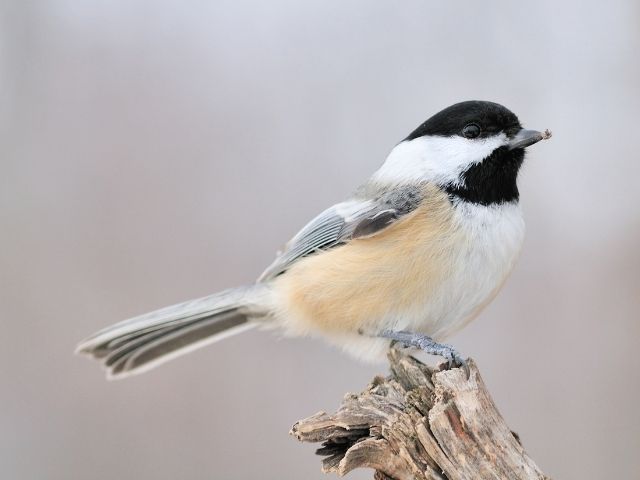
You're likely to spot this chickadee in northern Utah and some eastern parts.
A black-capped chickadee is a small species with a round head bigger than its body. You'll notice its black bib and head, white cheeks, white underparts, and gray upperparts.
It's also very curious, always exploring places and things in your backyard. When you set up a new bird feeder, this chickadee will be the first to see what's inside. If you watch it closely, you'll see it carry some seeds away from the feeder several times.
A black-capped chickadee isn't choosy; therefore, you can use a hanging or window feeder, as long as you put suet, peanuts, and sunflower seeds. Plus, install a nest box with sawdust or wood shavings about 60 feet from a wooded area to deter wrens.
The meal depends on the season. It prefers berries, seeds, and pieces of frozen carcasses in winter. In the other seasons, it adds insects like spiders to the menu.
4. American Dipper
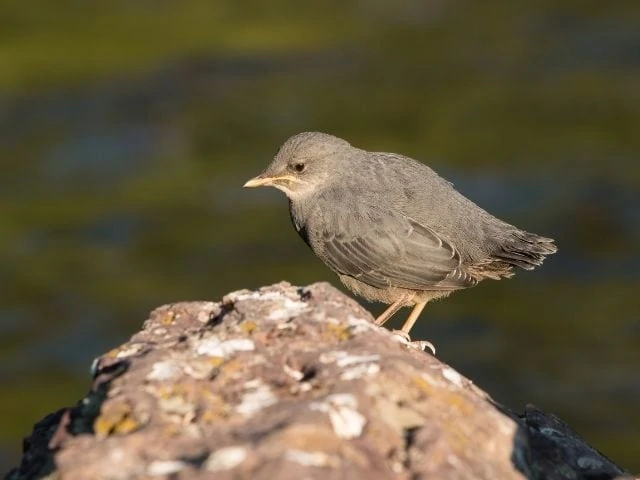
You'll only see it in the western side of North America, so bird watching in Utah grants you that privilege. An American dipper is the only aquatic songbird on this continent, meaning it hunts in water.
Therefore, you'll see it swimming, walking, or flying over streams to watch its food below. It also nests close to a stream for protection from predators. Such nesting grounds are limited, the reason there's a lower population of this songbird.
An American dipper's favorable nesting grounds are cliff edges, boulders, under bridges, or near waterfalls.
It's a grayish-brown bird with a sharp bill and a short tail. The breeding bird has a dark bill, while the nonbreeding one has a yellowish one and barred underparts. It's about the size of an American robin, averaging 5.5 to 7.9 inches long.
5. American Robin
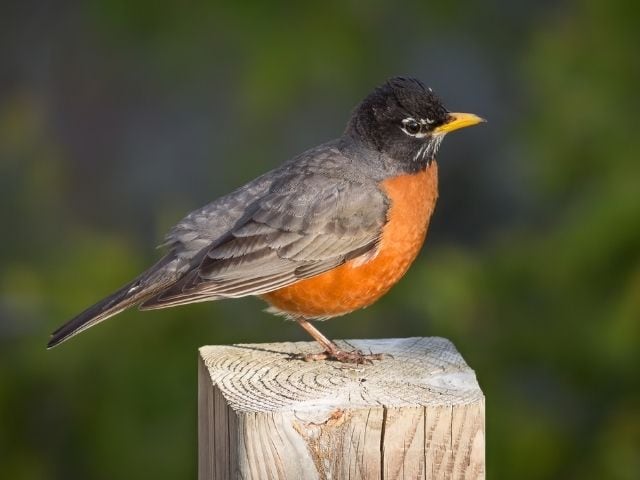
It winters in the southern states of the US and spends the breeding season north. But, fortunately, there is an all-year-round population in the central states, so you'll see it in Utah.
You'll spot it in open woodlands, farmlands, and urban areas like parks and lawns. You may find American robins in flocks of other species like the mountain bluebird. It eats worms, berries, and it may also come for fruits in your bird feeder.
Most birders use the body length of an American robin to compare the size of small and medium birds since it's medium-sized, growing between 7.9 and 11.0 inches long. This species has a long tail, a plump body, and a straight, slender bill with a curved tip. Its upperparts are grayish, while its underbelly has a rusty orange color.
6. California Condor
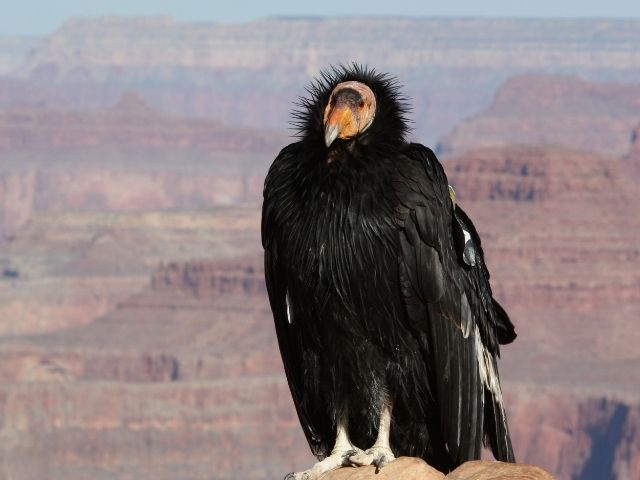
It's the largest species you'll see in North America, and it's in about five states only. Fortunately, it's one of the birds of Utah, found in its southern region. Other states lucky to host it are Arizona, Nevada, and California.
Further, it soars slower than the bald eagle. It takes 16 seconds for a full circle, whereas a bald eagle takes about 14 seconds.
You'll see it scavenging in mountain forests, beaches, or meadows. Its favorite carrion includes mammals like cattle, rabbits, and whales.
It can build a nest in a cave that's over 6,000 feet from the ground. The eggs incubate on the floor or a pile of debris for 53 to 60 days, and nestling can last up to three months.
An adult California condor has broad wings with long tips that look like fingers, plus a yellowish head. It has black plumage, but its wings are white underneath. Thie body length averages 46.1 to 52.8 inches, while its wingspan is 109.1 inches.
7. Great Horned Owl
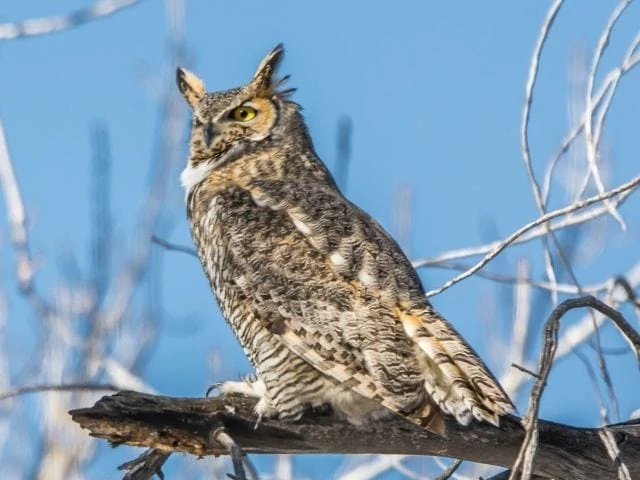
It's a common predator, one you can see in all Americas.
Its ID details are two horn-like tufts on its crown, an eerie stare with its yellow eyes, mottled grayish-brown plumage, and a reddish-brown face.
A great horned owl attacks both birds and mammals, and it can take on animals larger than its 18.1 to 24.8 body length. Since it's nocturnal, you'll see it at dusk perched on fence posts or trees on the edge of open fields.
The best places to search for it are the woods, deciduous forests, parks, cities, wetlands, evergreen forests, open areas, and deserts. It's almost everywhere!
Its menu is as diverse as its habitats as a great horned owl eats raptors, rabbits, mice, ducks, grebes, insects, fish, and bats.
After watching its prey from above, it lands and walks on the ground until it traps it.
This owl doesn't build nests; instead, it lays eggs in nests made by other species, on the ground, or in a tree cavity. When it finds a potential nest, it roosts around it for some time before using it.
8. Great Blue Heron
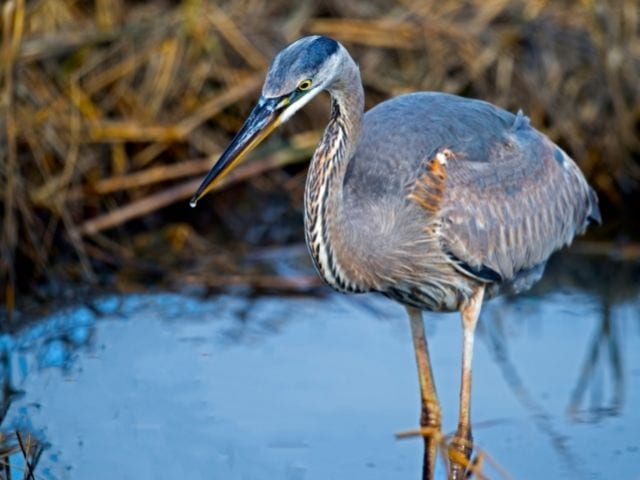
It's not a regular at feeders, but it may show up if there's a fish pond in the vicinity.
It's a large bird with a long neck, grayish-blue plumage, a long orange-yellow bill, and head plumes.
Great blue herons are bulky, but they weigh about 6 pounds only. Their body length is between 38.2 and 53.9 inches.
To see these herons in the wild, explore river banks, shores of estuaries, and marshes. They nest on different sites, from trees to mangroves, in colonies with hundreds of nests built over 100 feet from the ground.
9. Spotted Towhee
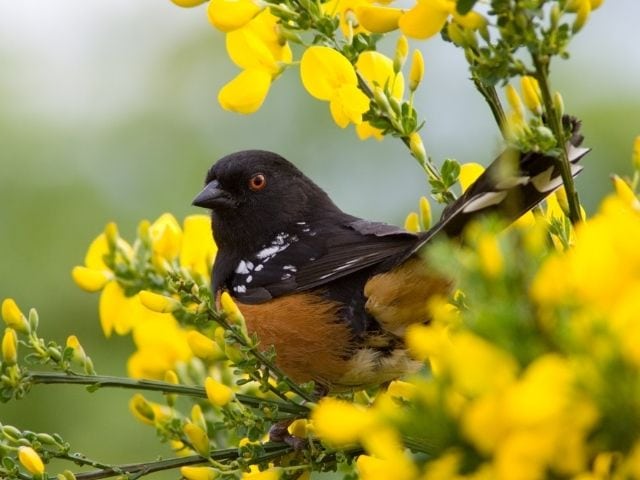
You'll spot this sparrow in the western states, so that's how it ends up in Utah. You'll love its plumage. A male has a black head and back with white spots on its wings. Its belly is white while the sides are rufous. The tail looks rather long for such a small, plump bird.
Females have brownish-black plumage as if they've just come out of a dust bath. Both sexes' body size is between 6.7 and 8.3 inches, a few inches larger than a song sparrow.
They love open shrubs with undergrowth, forest edges, and of course, your backyard feeder.
10. Downy Woodpecker
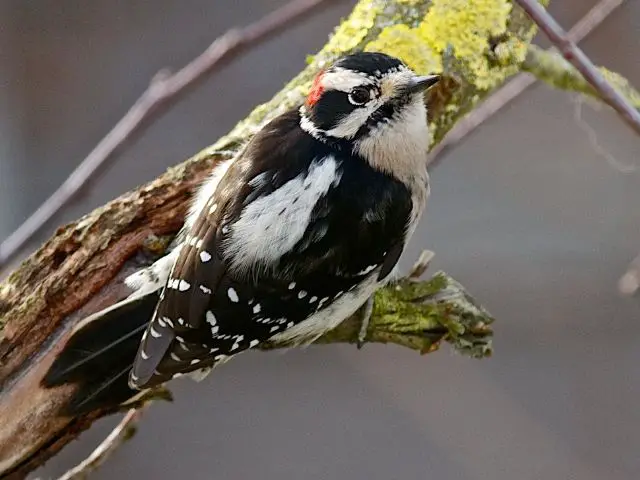
It's the smallest woodpecker in the US, flaunting a body length between 5.5 and 6.7 inches. You'll know it by its characteristic black and white plumage with a red nape on the male bird.
It also loves visiting a feeder of homeowners who offer black oil sunflower seed, millet, or peanuts.
If you're such a backyard birder, make sure to leave some dead trees where a downy can build a nest. When it does, you'll find three to eight white eggs that'll hatch in 12 days.
Fun Fact: The Downy Woodpecker is likewise making a big scene in the Big Apple! Read all about it by visiting "Woodpeckers In New York".
11. Yellow Warbler
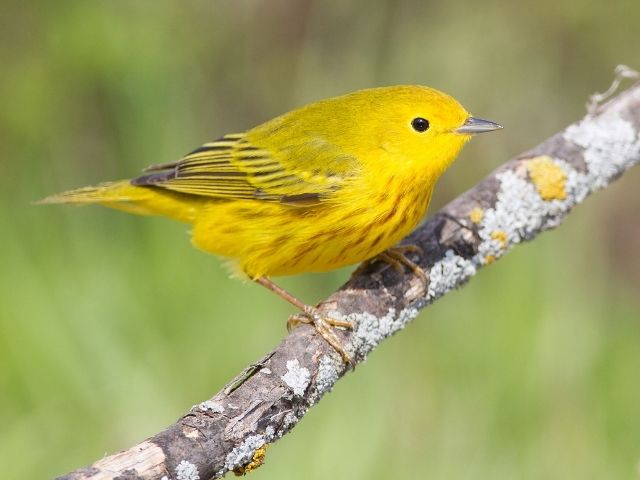
North America is its breeding and migration range. Its body length is between 4.7 and 5.1 inches; therefore, it's larger than an American goldfinch. You'll ID a yellow warbler by its bright yellow plumage and black eyes. The male bird has reddish streaks on its underside.
To attract yellow warblers to your bird feeder, leave suet or peanut butter. Further, plant trees loved by insects and caterpillars as these also form a yellow warbler's diet.
These wild birds live in willow, alder, and cottonwood.
The materials used include bark strips and grass. The exterior decor has spiderwebs or plants, while the interior lining is deer hair or plant fiber.
Places To Visit When Birding In Utah
After learning about the avian wealth of this state, it's time to go birding. Here are a few places to visit:
Tracy Aviary
This Salt Lake City attraction is the oldest in the country, and it has numerous educational programs that include field trips. It has both guided and self-guided programs.
Natural History Museum Of Utah
Explore thousands of specimens from almost 600 species. Yes, it's going to be a fun learning experience.
Canyonlands National Park
With over 270 birds recorded in this park, you'll want to add it to your list of places to explore. The Colorado River is one of the reasons birds always find food here.
Antelope Island State Park
You'll see a variety that includes the burrowing owl, long-billed curlew, and a few types of sparrows.
Zion National Park
Its many ecosystems house populations of the California condor, peregrine falcon, spotted owl, and the mountain bluebird.
Great Salt Lake Birding Trail
This region's wetlands attract dozens of migrating birds. The Utah Division of Wildlife Resources runs an ecosystem program to collect data about avian activity in this important zone with over 330 species.
Watch this birding video for the Great Salt Lake area of Northern Utah:
Ouray National Wildlife Refuge
Green River is the lifeline of this refuge, providing wetlands loved by double-crested cormorants, grebes, northern flicker, and the American bittern.
FAQs About Utah Birds
What Are The Most Common Birds In Utah?
You're more likely to see American robins, northern flickers, mourning doves, house sparrows, house finches, European starlings, and black-billed magpies but their frequency changes across seasons, with some birds more prominent in winter than in summer. For that reason, if you're birding in winter, you'll see the European starling, the house finch, the dark-eyed junco, and the black-billed magpie more than other species.
On the other hand, bird watching in summer offers more sightings of the American robin, mourning dove, and barn swallow. Some species aren't in the whole state. For instance, the tundra swan is a migratory bird in northern Utah.
How Many Bird Species Are There In Utah?
There are over 460 birds in Utah, a good number given this state's strategic location along the route of some migratory birds. For that reason, even if you don't go to the parks and forests to see most species, you can attract them to your backyard feeder.
Stan Tekiela has a book titled Birds of Utah that gives you comprehensive birding information. He details each species, stating bird identification information like its size, nesting site, food, and plumage. He also gives brief personal notes about each bird.
What Kind Of Finches Are In Utah?
This state has over ten of them including species like the American goldfinch, evening grosbeak, house finch, and pine siskin.
What Kind Of Sparrows Live In Utah?
You'll see over 20 types in this state. In addition to the house sparrow, you'll spot horned lark, swamp, vesper, and savannah sparrows.
In conclusion:
Final Thoughts
Utah can treat you to unforgettable birding tours. With over 460 species, you can even schedule a tour to see one variety at a time, say, search for finches or woodpeckers only.
You'll see avians and explore the state's ecosystems ranging from deserts to riverine forests.
But, you can also skip the walking or camping tours and wait for avians to explore your bird feeders.
So, where would you like to start your tour of Utah's avian wealth? At home or in a park?

